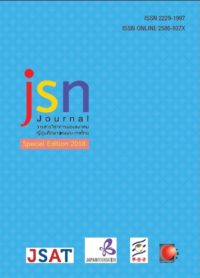ความเป็นแม่ในวรรณกรรมเรื่องคิโนะกะวะของอะริโยะฌิ ซะวะโกะ
Main Article Content
บทคัดย่อ
บทความวิจัยนี้มีจุดมุ่งหมายเพื่อศึกษาความเป็นแม่ที่ถูกสร้างขึ้นในวรรณกรรมเรื่องคิโนะกะวะ (Kinokawa. 『紀ノ川』) ของอะริโยะฌิ ซะวะโกะ (Ariyoshi Sawako. 有吉佐和子) โดยผู้วิจัยต้องการศึกษาวิเคราะห์ว่า มีการนำเสนอภาพความเป็นแม่ของตัวละครเอก ฮะนะ (Hana. 花) ฟุมิโอะ (Fumio. 文緒) และฮะนะโกะ (Hanako. 華子) ที่เป็นผู้หญิงในยุคเมจิ ไทโช และโชวะอย่างไร ปัจจัยทางสังคมใดที่หล่อหลอมให้เกิดความเป็นแม่นั้น ซึ่งผู้วิจัยพบว่าปัจจัยทางสังคมที่สำคัญประการหนึ่งคือ การศึกษาสำหรับผู้หญิงญี่ปุ่นที่ช่วงแรกยังคงยึดแนวคิดของ “ภรรยาที่ดีแม่ที่ฉลาด” (ryousai kenbo. 良妻賢母) เป็นพื้นฐาน โดยตัวละครหญิงในวรรณกรรมต่างก็ได้รับการศึกษาทั้งจากที่บ้านและที่โรงเรียน อันเป็นการหล่อหลอมให้เกิดความเป็นแม่ทั้งจากรูปแบบคำสอน และจากเนื้อหาในตำราเรียน ทั้งนี้ผลการศึกษาจะเห็นได้ว่าลักษณะความเป็นแม่ของฮะนะและฟุมิโอะนั้นมีความแตกต่างกัน โดยฮะนะเป็นแม่ที่เชื่อมั่นในหน้าที่ของผู้หญิงตามที่สังคมคาดหวัง เชื่อว่าหน้าที่ของผู้หญิงคือการให้กำเนิดและเลี้ยงดูบุตร พร้อมจะเสียสละความสุขส่วนตัวเพื่อครอบครัว ซึ่งเกิดจากการถูกปลูกฝังผ่านคำสอนของผู้เป็นยายและเนื้อหาที่เรียนในโรงเรียน ส่วนฟุมิโอะไม่ได้ยึดถือในหน้าที่ของภรรยาและแม่ ความเป็นแม่ของฟุมิโอะนั้น ไม่ได้เริ่มจากความเชื่อมั่นต่อหน้าที่ของภรรยาที่ดีแม่ที่ฉลาด อีกทั้งการเรียนในโรงเรียนไม่ได้เน้นแค่การเป็นแม่และภรรยาแต่เพียงอย่างเดียว ฟุมิโอะจึงมีลักษณะของแม่ที่มีความคิดสมัยใหม่ตามแบบผู้หญิงยุคไทโช สำหรับฮะนะโกะเป็นตัวละครหญิงที่ยังไม่มีครอบครัว จึงไม่อาจเห็นถึงความเป็นแม่ได้อย่างชัดเจน แต่การโหยหาความเป็นครอบครัวยุคเก่าและการใช้ชีวิตร่วมกับฮะนะผู้เป็นยาย เป็นการสร้างแรงบันดาลใจต่อการดำเนินชีวิตครอบครัวของฮะนะโกะ
Article Details
ข้อความและข้อคิดเห็นต่างๆ ในบทความเป็นของผู้เขียนบทความนั้นๆ ไม่ใช่ความเห็นของกองบรรณาธิการหรือของวารสาร jsn Journal
เอกสารอ้างอิง
Ariyoshi, Sawako. (1959). 『紀ノ川』. 新潮社.
Ariyoshi, Sawako. (2000). 「伝統美の目覚め/父恋い酒」.『有吉佐和子(作家自伝109) 』. 日本図書センター.
Fujita, Mariko. (1989). “It’s All Mother’s Fault”: Childcare and the Socialization of Working Mothers in Japan. The Journal of Japanese Studies, Vol. 15, No. 1: p. 67-91.
Greer Litton Fox. (1980). The Mother-Adolescent Daughter Relationship as a Sexual Socialization Structure. National Council on Family Relations, Vol. 29, No. 1, pp. 21-28.
Iwatani, Daishi. (1970).「評伝的解説<有吉佐和子>」足立巻一他編.有吉佐和子・瀬戸内晴美集. 現代日本の文学49. 学習研究社.
Janeke van Mens-Verhulst, Karlein Schreurs and Liesbeth Woertman. (1993). Daughter-ing and Mothering: Female Subjectivity Reanalysed. Routledge, Newyork.
Koyama, Shizuko. (1991). 『良妻賢母という規範』. 第 1版. 勁草書房.
Miyano, Maoko. (2016). 「母性と幸福―自己として、女性として生きる」. 社会と倫理 第31号.
Miyauchi, Junko (ed). (1995). 『有吉佐和子・新潮日本文学アルバム71』. 新潮社.
Niwa, Akiko and Tomiko, Yoda. (1993). The Formation of the Myth of Motherhood in Japan. U.S.-Japan Women’s Journal, English Supplement No. 4: pp. 70-82.
Ruth Benedict. (1946). The Chrysanthemum and The Sword. Houghton Mifflin Co., Boston. Translated by Matsuji, Hasegawa. (1967).『菊と刀―日本文化の型―』. 社会思想社, 東京.
Sandaya, Hikaru. (1932). Motherhood Education in Japan. Childhood Education Journal,Vol. 8, Issue 5: p. 256-258.
Tsuchida, Youko. (2014). 「公立高等女学校にみるジェンダー秩序と階層構造学校・生徒・メディアのダイナミズム」. 『MINERVA 社会学叢書 45』.
Yagi, Kimiko. (1986).「母性イデオロギー一考」. 『城西大学女子短期大学部紀要』. 3(1): pp.45-56.
Yoshida, Akiko. (2017). Unmarried Women in Japan: The drift into singlehood. Routledge, Newyork.


